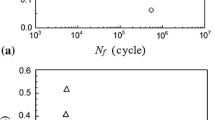The short fatigue short crack replica tests using LZ50 axle steel hourglass-shaped specimens of were carried out under rotating-bending cyclic load. Seven sets of effective test data were obtained. The analysis demonstrated that short fatigue cracks generally originate in ferrite grains or on their boundaries, and then short cracks start propagating, which is strongly influenced by the microstructure of the material. The crack growth rate increases serratically, followed by its decrease double-fold because of the limit of ferrite grain boundaries and the banded pearlite structure. Based on the three principles of the best fit, which include the overall fitting effect, correlation with fatigue physics, and safety of residual strength prediction, the statistical evolution of the dominant effective short fatigue crack length and life share were analyzed. The statistical results show that the minimum value distribution exhibit the best fit of the dominant effective fatigue short crack length and the life share. The short fatigue crack growth model, which includes various microstructure barriers, provides a good fitting result and reflects the cyclic effect of the microstructure on the short fatigue crack behavior.









Similar content being viewed by others
References
C. Y. Chen, Fatigue and Fracture [in Chinese], Huazhong University of Science and Technology Press, Hubei (2001).
S. Suresh, Fatigue of Materials, Cambridge University Press (1998).
Y. S. Hong and B. Fang, “The mesoscopic process and theory of short fatigue cracks initiation and propagation,” Adv. Mech., 23, 468–486 (1993).
TB/T 2945-1999. LZ50 Axle Railway Vehicle and Steel Billets Technical Conditions, Chinese Standard, Implemented on September 1, 1999.
B. Q. Ma, Comparison of Short Fatigue Crack Behavior for LZ50 Axle Steel under Two Different Loading Frequencies [in Chinese], Southwest Jiaotong University, Chengdu (2016).
Y. X. Zhao, Q. Gao, and J. N. Wang, “Experimental observation on the short fatigue crack behavior of a stainless steel pipe-weld metal I – Material microstructures and research approach,” Acta Metall. Sin., 36, 931–936 (2000).
Y. X. Zhao, Q. Gao, J. N. Wang, “Experimental observation on the short fatigue crack behavior of a stainless steel pipe-weld metal II – Crack initiation, growth and interaction,” Acta Metall. Sin., 36, 937–943 (2000).
Y. X. Zhao, B. Yang, and Q. Gao, “Initiation and early propagation of short fatigue cracks on weld metal of 1Cr18Ni9Ti pipes,” Nucl. Power Eng., 24, 127–132 (2003).
Y. X. Zhao, B. Yang, and Q. Gao, “Experiment of physical short fatigue crack propagation of 1Cr18Ni9Ti weld metal,” Nucl. Power Eng., 26, 584–589 (2005).
Y. X. Zhao, Analysis of Low Cycle Fatigue Short Crack Behavior and Reliability, PhD Thesis, Southwest Jiaotong University, Chengdu (1998).
Y. X. Zhao, B. Yang, and Q. Gao. “Equation of short fatigue crack growth law of 1Cr18Ni9Ti weld metal,” Nucl. Power Eng., 26, 590–597 (2005).
Y. X. Zhao, Y. F. Sun, and Q. Gao, “Unified linear regression method for the analysis of seven commonly used statistical distribution,” J. Mech. Strength., 23, 102–106 (2001).
B. Yang and Y. X. Zhao, “Experimental research on dominant effective short fatigue crack behavior for railway LZ50 axle steel,” Int. J. Fatigue, 35, 71–78 (2016).
B. Yang, B. Q. Ma, S. N. Xiao, and Y. X. Zhao, “A probabilistic model for describing short fatigue crack growth behavior of LZ50 steel,” Strength Mater., 48, No. 1, 90–97 (2016).
Acknowledgments
Present work is supported by the National Key R&D Program of China (2016YFB1200403), the National Natural Science Foundation of China (51675446 and U1534209), and the Opening Project of State Key Laboratory of Traction Power (grant No. 2015TPL_T13).
Author information
Authors and Affiliations
Corresponding author
Additional information
Translated from Problemy Prochnosti, No. 1, pp. 212 – 222, January – February, 2018.
Rights and permissions
About this article
Cite this article
Yang, B., Dai, S., Wu, Y.Y. et al. Short Fatigue Crack Behavior of LZ50 Axle Steel Under Rotating-Bending Cyclic Loading. Strength Mater 50, 193–202 (2018). https://doi.org/10.1007/s11223-018-9959-8
Received:
Published:
Issue Date:
DOI: https://doi.org/10.1007/s11223-018-9959-8




